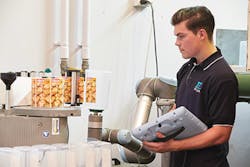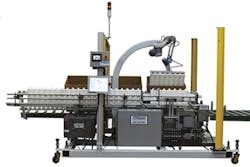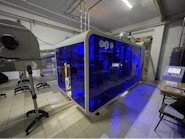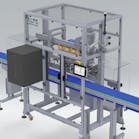Collaborative robots have created a lot of buzz in manufacturing plants over the past several years, and with good reason. The ability of collaborative robots, or cobots, to share a workspace with humans is opening up new possibilities in plastics processing plants. The question is: How can we protect humans sharing that workspace from injury?
Technology has advanced to the point where it is possible for humans and robots to work in the same space without exposing humans to danger, according to Carole Franklin, director of standards development at the Robotic Industries Association (RIA) in Ann Arbor, Mich.
In the standards arena, industrial robot safety is addressed in ISO 10218, which the International Organization for Standardization issued in 2011. That standard was used as the basis for the American National Standards Institute (ANSI) standard ANSI/RIA R15.06, which covers safety features in industrial robots in the U.S. The standard mentions collaborative robots, but doesn't provide a lot of detail, Franklin said.
Recently, cobot safety has received a lot more attention. In February, ISO published Technical Specification (TS) 15066, which provides more detailed information on the safe implementation of cobots. As a technical specification, TS 15066 does not yet carry the full weight of a standard. Its content still needs to mature, but eventually will likely be absorbed into a future version of the base standard or will itself become a standard. For now, it is meant to build on the ISO 10218 standard.
"The important thing with [cobots] is to make sure that if there is contact between the robot and the human, the human will not be harmed," Franklin said. To that end, TS 15066 includes data from a pain onset study at the University of Mainz in Germany, which was commissioned by the ISO. The study was conducted under ethical guidelines with 100 volunteers to study the onset of pain on 29 areas of the body. The idea, Franklin explained, was that if a person were to be injured, he or she typically would experience pain first. Therefore, preventing pain should prevent injury.
TS 15066 classifies four types of collaborative operation:
Safety-rated monitored stop, which means the robot stops when a person enters its workspace, while leaving the robot in a powered-on state.
Hand guiding, which refers to physically manipulating the robot during the automatic training mode.
Speed and separation monitoring, in which an external safety device such as a scanner causes the robot to slow down if a human enters a workspace, to maintain a protective distance between them.
Power and force limiting, in which inherent safety features slow down or stop the robot to avoid injury to a human. Power- and force-limiting robots do not have sharp points, exposed motors or pinch points and may be equipped with padding to prevent injuries.
TECHNOLOGY DEVELOPMENTS FOR SAFE COLLABORATION
"The difference between a traditional industrial robot and a power- and force-limited robot is that more safety features are built into the robot versus being external to the robot," said Roberta Nelson Shea, global technical compliance officer of Universal Robots A/S, Odense, Denmark. The company is a supplier of collaborative industrial robots and has its U.S. headquarters, Universal Robots USA Inc., in Ann Arbor.
She said that power- and force-limiting robots have the capability to monitor speed, torque and force, and to set limits that will prevent injury if a person comes into contact with them. This is a paradigm shift that sets collaborative robots apart from traditional robots, she said.
Brian Benoit, senior product manager of Boston-based Rethink Robotics, agrees. He said the company designs its robots in the power- and force-limiting category to work collaboratively with humans.
One way it achieves that is by equipping robots with series electric actuators that sense contact and physically flex on contact to absorb energy. Encoders measure the deflection resulting from the contact, indicating the amount of force.
"This means that our robots are very sensitive to any inputs from the outside environment," Benoit said.
Other suppliers of industrial robots have entered the cobot market. ABB Inc., Auburn Hills, Mich., offers the YuMi robot, which has a payload of 1.1 pounds and is designed to prevent injury if contact occurs.
Nicolas De Keijser, assembly and test line manager of ABB Robotics, said, "The lightweight, padded, magnesium arms can cease operation in milliseconds, if necessary — for instance, in the event of an unexpected collision — contributing to the overall safety of the robot's co-workers."
In April, Stäubli Corp., Duncan, S.C., will introduce TX2 articulated robots and the CS9 controller in the U.S. market; both have previously been available in Europe. Paul Deady, the company's automotive segment manager, said both products are designed for collaborative operation.
The TX2 robots will have low-to-medium payload capacities ranging from about 3 pounds to 15 pounds. They will feature two types of collaborative operation: safety-rated monitored stop, and speed and separation monitoring.
"Our vision is to be able to span the full bandwidth of human collaboration," he said. Eventually, the robot line will incorporate power- and force-limiting capability.
COLLABORATION MEANS A COMPREHENSIVE LOOK AT SAFETY
Suppliers said that no part of the collaborative robot should be overlooked when it comes to safety, including end-of-arm tooling (EOAT). Shea of Universal Robots said that ISO is currently working on technical reports regarding end-effector, or EOAT, safety.
"We are trying to point out some things that might not occur to people who put these things together," she said. For example, safety-rated speed control of a robot should be integrated with the end effector; also, end effectors on a collaborative robot should be designed to grab with the least force needed to hold the part.
In Deady's view, collaborative robot applications should be thought out in a comprehensive way to maximize safety. "You can have a robot that is rated safe to be around people, but if you've still got energy in the tool, with [for example] pneumatics, that can be a problem," he said. "You have to look at this in a completely holistic way and design your system around those risks."
Benoit of Rethink Robotics agrees. "We develop end effectors or end-of-arm tooling here that we think [is] inherently safe. There is no clamping hazard with any of our kits that we sell," he said. Clamping force on a gripper supplied by an electric motor is below the threshold that would cause injury, and the same principle applies to vacuum grippers, he noted.
He added that end effectors, as well as the parts that will be moved around, need to be considered along with the robot arm when evaluating the safety of a particular application. Payload and speed also should be considered, regardless of the inherent safety of the robot, Benoit said. "One of the things that is important for a collaborative robot is that it works on a human scale. During a risk assessment, the types of parts that it is holding matter," he said.
Benoit said that collaborative robot work cells differ fundamentally from work cells with traditional robots. "When you are designing a work cell for an industrial robot, everything is in a cage, so a person is not in any path of the robot," he said. "With a cobot, it's different. You might not have the part move that is at head level or eye level; those are the high-risk areas of the body. You might design your tasks differently, if there is a possibility of a person interacting or sharing the work space with the robot."
MOBILE COLLABORATIVE AUTOMATION FOR BLOW MOLDING
Proco Machinery Inc., Mississauga, Ontario, has launched a cobot system for the blow molding industry. The Robo Packer system, which was introduced in June, incorporates a six-axis cobot supplied by Universal Robots and is designed for pick-and-place, assembly and packaging applications.
The system is supplied as an integrated module that consists of the robot, in-feed conveyor and box conveyor. The components are mounted on a common frame fitted with leveling pads and casters, allowing the unit to be moved alongside the blow molding machine and be quickly set up for production.
Robo Packer takes a slightly different approach to the concept of a cobot in a work cell, in which the human works as part of the production process.
"There are some applications where you can do that," said Siva Krish, sales manager of Proco Machinery. "But when it comes to automated packaging, you don't want to have a human sitting next to the robot."
The company says the Robo Packer does not require the safety guards that are normally used with traditional work cells; however, it does offer guards as optional equipment.
David Desbarres, Proco's technical services manager, explained that the collaboration in this application allows the human operator to enter the work cell to make an adjustment or fix a problem without shutting down the whole cell. Robo Packer is capable of running at two speeds: 1,000mm per second for normal production and 250mm per second in the collaborative mode. A U-shaped safety zone protected by a light curtain slows the robot's action to the collaborative speed; the robot resumes production speeds when the person exits the safety area.
The robot arm is very sensitive and can detect a small amount of resistance. If the arm bumps into an object, it will stop immediately and can be quickly reinitialized to resume operation.
John DeGaspari, senior correspondent
Contact:
ABB Inc., 248-391-9000, www.ABB.com/robotics
Proco Machinery Inc., 905-602-6066, www.procomachinery.com
Rethink Robotics Inc., 617-500-2487, www.rethinkrobotics.com
Robotic Industries Association, 734-994-6088, www.robotics.org
Stäubli Corp., 864-486-5421, www.staubli.com
Universal Robots USA Inc., 844-462-6268, www.universal-robots.com







